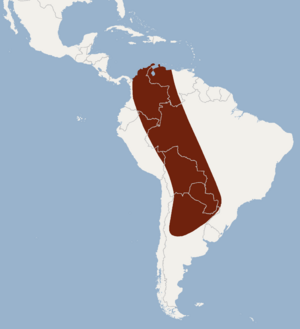Big bonneted bat facts for kids
Quick facts for kids Big bonneted bat |
|
|---|---|
| Conservation status | |
| Scientific classification | |
| Genus: |
Eumops
|
| Species: |
dabbenei
|
 |
|
| Distribution of Eumops dabbenei | |
The big bonneted bat is a type of bat found in South America. It's also known as Dabbene's mastiff bat. Its scientific name is Eumops dabbenei. This bat belongs to the Molossidae family, which are often called free-tailed bats. It was named after a conservator from a museum in Buenos Aires.
What Does It Look Like?
The big bonneted bat is a fairly large bat. Adult bats are about 19 centimeters (7.5 inches) long. They weigh around 100 grams (3.5 ounces). That's about the weight of a small apple!
Its tail is thick and measures about 6 centimeters (2.4 inches). The bat's fur can be chestnut brown or pale grey. Its belly fur is usually lighter than its back.
The ears of this bat are wide but short. They meet together at the base, right in the middle of its forehead. Compared to other bats in the Eumops group, the big bonneted bat has a bigger body. It also has a short, wide nose and short ears. Its nostrils do not form a tube shape. Male big bonneted bats have a special gland on their throat. This gland makes a liquid that can stain their fur.
Where Do They Live?
Big bonneted bats live in two main areas of South America. One group lives in the northern parts, like Venezuela and Colombia. Another group lives in the southern parts, including Bolivia, Paraguay, and northern Argentina. One bat was even seen in a wetland area in southwestern Brazil.
There are no different types or subspecies of this bat. They like to live in places with low plants and scattered patches of tropical forest. They can be found at heights up to 1,100 meters (3,600 feet) above sea level.
How Do They Live?
Big bonneted bats are insectivorous. This means they eat insects. They often rest or "roost" in hollow trees. They also use man-made places like houses for their roosts.
When these bats are looking for food, they have been heard making very loud, high-pitched sounds. Scientists don't know much about how they have babies. However, young bats have been seen in December and January.
See also
 In Spanish: Eumops dabbenei para niños
In Spanish: Eumops dabbenei para niños


